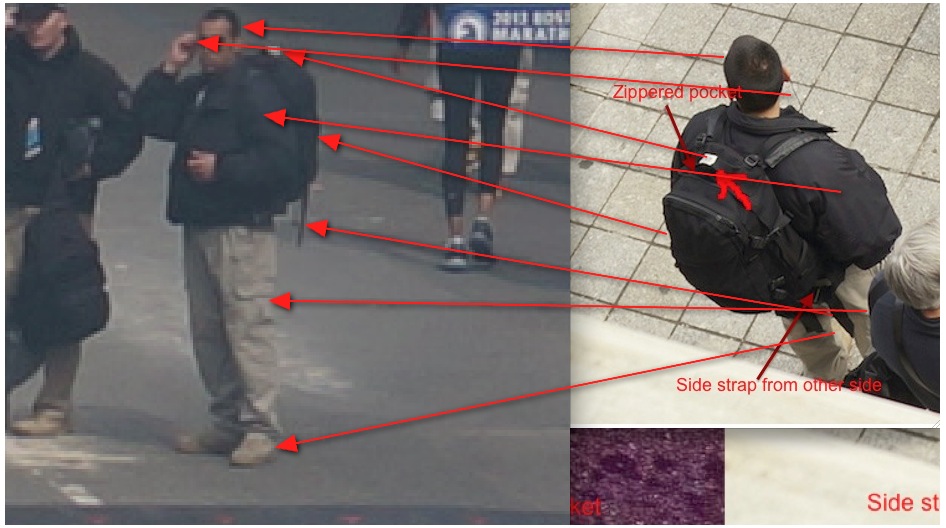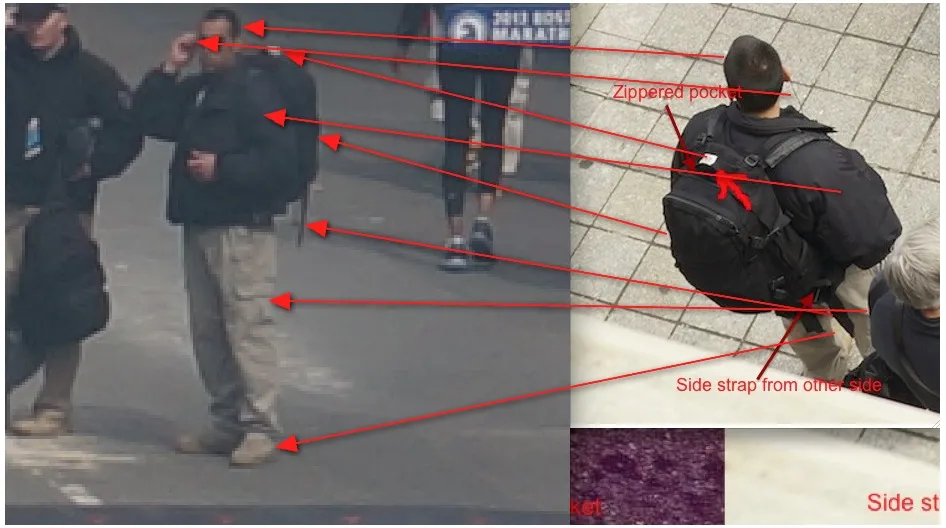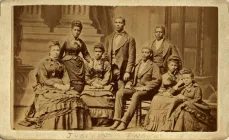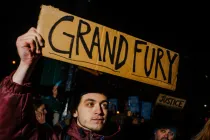As a follow up to the Theorizing the Web 2015 #TtW15 conference hosted in our new space on the Bowery, we present a selection of photography-focused presentations from the conference authored by a diverse set of academics, activists, artists, and journalists.
In the following I will discuss the aesthetics of photographic practices on conspiracy theory websites. The literature on conspiracy theories tends to treat them harshly, for example, they are described as being the result of "crippled epistemologies"1. Rather than seeing conspiracy theories, and their attendant photographic practices, as simply failures, I would like to try and locate them in terms of wider photographic and filmic practices.
The Problem with Documentary
The notion of bearing witness has carried particular salience in photojournalistic discourse over the 20th century. Kevin Carter's Pulitzer Prize winning photo of a vulture, lingering behind a starving child is perhaps the epitome of this relationship between photographer and subject. Whilst it is impossible to look at this image without feeling some bodily reaction of horror, there is nothing within this image that can explain why the girl is starving. The photographer, by placing this image in front of the viewer, who looks from a position of safety and comfort, does nothing to displace the global relations of power that underlie what is depicted.
One could argue that there is always an inherent pleasure at looking at an image, no matter how deplorable what we are looking at is. Jill Godmillow terms this "the pornography of the real"2.. This becomes a central problem for any politically conscious image making—how to represent injustice without making what is represented into a spectacle.
In the age of ubiquitous photography, where almost everyone in large parts of the world, has access to a smart phone, the spectacle of suffering has never been more easily available, and yet the underlying causes have never been so obscured.
When we think about citizen journalism, it becomes interesting to see how, outside of the professional and institutional context of photojournalism, the questions and problems of representation don't disappear, but seem to mutate into new formations. Normally when we receive photographic images, in a journalistic or documentary context, they are narrativized. That is, they are located within a story, or at the least captioned. We are told what we are looking at. The professional and ethical codes of journalism guarantee the veracity of what we are shown.
The Boston Marathon bombing marks a watershed moment in this relationship between narrative and image. A huge volume of photographs, from spectators, journalists and CCTV cameras were available almost in real time. These images were received before any attempt at narrativising, or making sense of what had happened, could be attempted by the media. Within this absence of narrative, the ambiguity of photographic imagery became readily apparent; a photograph shows something but could mean anything.

Watching the news play out on my Facebook feed, I was struck by a type of image I had rarely seen before, cropping up again and again amidst the links to mainstream media outlets and statements of condolences or affirmations of personal safety. This type of image I was seeing, like the one above, was often accompanied by a small statement, or link to conspiracy theory website insinuating that the bombing was a "hoax" or "false flag." Seeing these posts I thought, "that's not how I think about the political" and "it's not how I think about the photographic" but I was fascinated at the attempt these images made at reconciling the two. By showing the connections between photographs, these images seemed to posit that they could describe the causes of the events they depicted. It is this type of image that I want to analyze here, but before that I will briefly define "conspiracy theory" and review the literature in the field.
Defining Conspiracy Theory
The, relatively scant, literature on conspiracy theory splits roughly into two camps—those who hold a consensus view of society, and those who see society as fundamentally antagonistic. In the former, conspiracy theorizing is seen as a pathology that damages the democratic process and presents a problem for good governance1. In the latter it is seen as serving the interests of power, as an "imaginary support for the social order that structures and regulates social relations, thereby lending ideological coherence to social reality" 3. Despite this opposition, the understanding of what actually constitutes a conspiracy theory is relatively uncontroversial. Drawing from Micheal Barkun's 4 and Richard Hofstader's work5, I define conspiracy theory as the belief that history is primarily determined by the covert actions of an individual or group, working towards their own ends.
Of particular salience to the present study is Fredric Jameson's work on conspiracy theory. He uses the term "cognitive mapping" to describe the ability of an individual to understand their relationship to the "totality of class relations on a global ([or multinational]) scale."6 He goes on to argue that ‘"Conspiracy, one is tempted to say, is the poor person's cognitive mapping in the post modern age; it is a degrade figure of the total logic of late capital, a desperate attempt to represent the latter's system, whose failure is marked by its slippage into sheer theme and content." 6 With this in mind, conspiracy theories, however problematic, reflect a real problem: How do we, as image makers, speak about the world when the basis of our image making, our personal experience, is so disconnected from the globalized causes of that experience?
Reading Conspiracy Theory Websites
The following analysis explores some of the solutions to this problem that have, however naively, been posited by conspiracy theorists. I take the web-post to be the main unit of analysis, as each web-post is an authorial statement. However the meaning of the web-post must be understood as being constructed on several different levels of meaning:
- Each image is taken to show something.
- The juxtaposition of images through collage or annotation.
- The narrative progression from beginning to end of each web-post, either filmic or literary.
- The sense made by reading across and between websites via hyperlinks and bookmarks.
The images are drawn from two web-posts, from two different conspiracy websites—infowars.com and hangthebankers.com. Infowars has, (almost certainly) the largest readership of any conspiracy website, having around 10% the monthly unique visitors as Fox News. Hangthebankers.com has a much smaller readership, at around 1% of Fox News. Both web-posts occurred a few days after the Boston Marathon bombing, and use the idea of a 'false flag' as a framing device. The term "false flag" originates from naval warfare, referring to an attack carried out by Nation A, disguised as Nation B, for the purpose of furthering Nation A's goals.
The Over and Underdetermined Photographic Image
The following images are taken from a post on Infowars.com by Peter Joseph Watkins on April 17, 2013. None of the photographs are by the author, and it is unclear if any of the images are his creation, but they are used rhetorically to argue his position within his web-post.

This image demonstrates what I term the over and underdeterminancy of the image. On the one hand the image is taken to be undetermined, that is the indexical qualities of it are in need of highlighting with the use of text and annotations. The man in the bottom right corner is described textually. The relationship between the women photographing a family, her line of sight, his position is shown graphically. None of these things are unapparent from looking at the un-annotated photograph. However the image then becomes overdetermined by these annotations. The fact of his head momentarily been turned away, is taken as evidence of something, that he is "not watching" the event. Similar the fact that he is obscured by the man with his baby from the women with the camera, is taken as indicative of a relationship between the man with the baby and the man in the bottom right corner, that he is shielding him. Rhetorically what this image does, it to play off the two poles of ideas about photographic veracity, firstly that "the camera never lies" and secondly " that you can't trust what you see in pictures." By using annotations to show that the latter point has been considered in regard to the indexical elements of the photo, the former is bypassed. That a momentary turn of the head should mean "not watching" is thus given the same status as a "black backpack" being a black backpack.

In this image we see a crop from the previous image compared to the same man seen from a different angle. Again, the image is taken to be so underdetermined that we need all these red lines to show the connection, and yet the fact that we are being shown the connections between images suggest that these connections are pertinent. In the bottom right hand corner of the image we can see that this collage has taken place on top of another collage. Normally evidence of photographic tampering is considered a sign to not trust the veracity of the image, but in the context of conspiracy theories the reverse seems to be the case. Barkun argues that the internet functions as a kind of 'echo chamber' in which conspiracy viewers are reflected and reinforce each other 7. Here it seems that that the more hands have touched an image, the more reliable it is.

For the third time in the web post the same photograph is used as a base for the image. Here the connection made between the events of the bombing and the events outside them is via symbolism, the skull motif Punisher logo being used to suggest that the man in black is a member of either the Navy Seals or an employee of the then defunct Blackwater corporation. This image is a literal attempt to cognitively map the events of the bombing onto the, legitimately troubling, relationship between the US government and private defense contractors. Jennifer McGee describes the image, familiar from films, of photos connected via pieces of string as the archetypical image of the conspiracy theorist. These images appear to be the contemporary equivalent.
Whilst the rhetoric on this web-post is in terms of implicit "proof", it is significant that this proof is in photographic terms. The means of mediation are both the source of power and cause of anxiety.
Montage and Coincidence
The Eisensteinian theory of montage cinema relies on the tendency of humans to see one thing, then another and to assume a relationship between the two. We see a gun firing, a man falling, and instantly understand a specific spatial and temporal relationship between the two. The presumably pseudonymous Clark Kent makes use of these techniques in his April 24, 2013 web-post on Hangthebankers.com.

The post begins on the current date, with a prediction made before the bombing nine days earlier.


The post cuts back to the events of the bombing itself, creating an implicit causal relationship between what is happening now, and what happened then. The visual language here is less sincere than on infowars.com, proffering the ironic language of memes, with the more serious part of the theory being made solely across the images, rather than within them.

The post then cuts to "suspect 1 being escorted away." Just like in a film, we know time has passed, because it was day and is now night.

We then cross cut, in both time and place, to congress passing a piece of legislation. The net effect of the web-post is to affirm the causal relationship this last image spells out, to argue that the events of the bombing were a distraction caused by the government to pass legislation and test martial law.
The language of filmic montage functions as both an easily understandable form of rhetoric by which the author makes his argument, and at the same time formally underscores the key belief that conspiracy, rather than coincidence, is the motive force of history.
Jameson writes that:
"Information technology will become virtually the representational solution as well as the representational problem of this world system's cognitive mapping, whose allegories can now always be expected to include a communicational third term." 8
The practices on these websites seem to confirm this, calling into service the means by which the world is represented (photographically and filmicly) to make sense of it.
Whilst these practices are extremely recent and only made possible by technology that has developed in the last decade, they do not require a great rethinking of the literature on conspiracy theories that was based on an analysis of textual sources. Rather these practices take naive understanding of photographic veracity and a more sophisticated understanding of filmic conventions, and use them to update the traditional forms of conspiracy speech.
In terms of solving the problem posited at the beginning of this essay, of representing the cause of suffering rather than the spectacle of it, these practices are almost certainly a dead end. They do, however, underscore the urgency and importance of this question, which still seems to be without satisfactory solution.
Oliver David (1989) is a filmmaker and writer. Born in London he now lives in Brooklyn. He has a BSC from the Unviersity of Bristol and is an MFA candidate at the School of Visual Arts.







